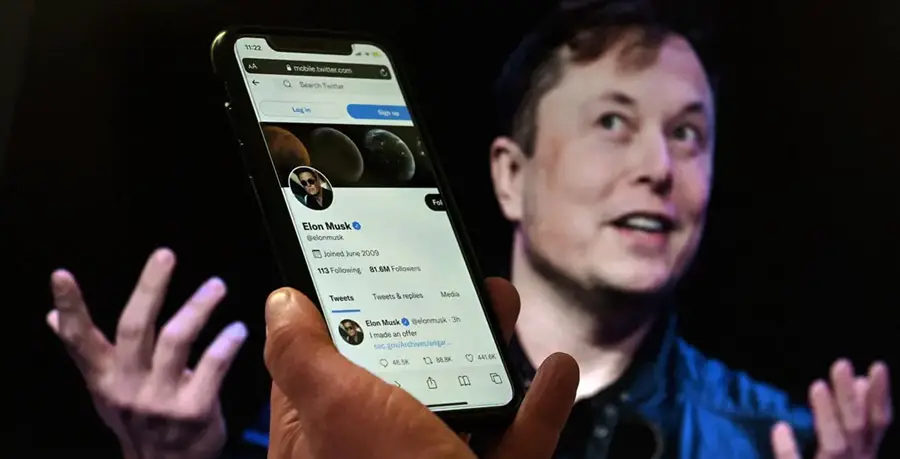Why does X (Twitter) label scam ads instead of removing them?
Remember the good old days… You see a scam on your favourite social media platform. You contact the platform and report the scam. They investigate, then they remove it so others don’t become a victim. Easy.
But with social media platforms continuing to grow, and scammers becoming increasingly effective at setting up high volumes of crooked adverts, many social platforms have struggled to keep on top of investigating user reports and removing the scam adverts.
We’ve written about Meta’s pithy attempts at removing get-rich-quick scams from their Facebook and Instagram platforms many times, for example. Meta’s AI continually fails to detect scam adverts even after they’re reported by their users.
Twitter, or X now, has also started to noticeably struggle. But Elon Musk’s platform has taken a somewhat novel approach to scam ads and scam companies operating on its platform. X has started “fact checking” deceptive or scam adverts, but inexplicably, it won’t actually remove them.
Sponsored Content. Continued below…
X uses a user-generated “community notes” feature to “add context” to tweets that may be misleading or deceptive which are appended to the tweet in question. Such notes are generated by approved X users. Yet even after X’s network of “community notes” users confirm that certain tweets or accounts are posting deceptive ads or even outright scams, X doesn’t seem particularly interested in removing them.
Take the below ad, for example.
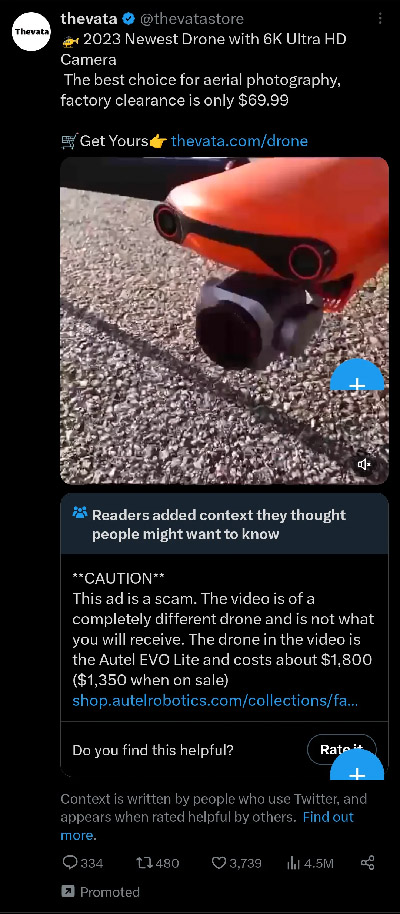
The X ad is for drone used for aerial photography. However X’s own community notes reveals that the drone used in the advert’s video is actually of an entirely different (and far more expensive) drone than what the buyer would actually receive. That’s a scam.
Similarly, take a look at the X ad below.
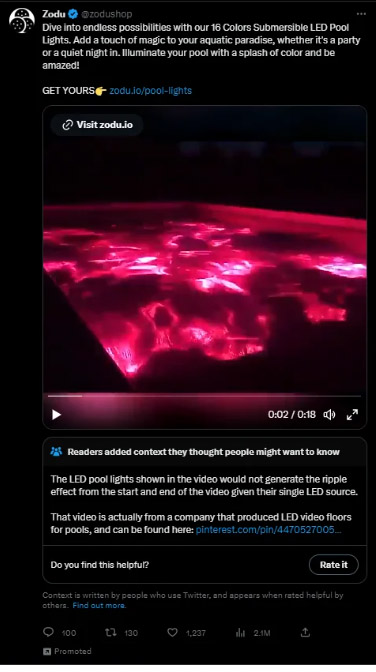
Again, this is advertising a product (pool LED lights) yet the images and video used in the advert are for different, more superior products than what the buyer would actually receive, as per the community notes on the advert.
Both the above tweets are examples of the surplus of Chinese dropshipping scams that have plagued the X (Twitter) platform since Musk took over, whereby scammers create Twitter ads using videos of genuine products, yet only deliver cheap knock-off products sourced from China and other countries.
X (Twitter) is most definitely aware of the practise. Their community notes users have even appended community notes to tweets from stores outlining how many of these scams work from stores that are known to sell counterfeit or knock-off products, as you can see from the tweet and community notes below.
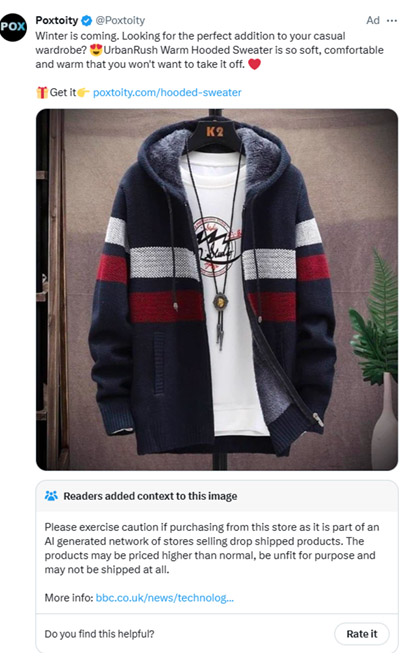
That’s right – X knows this account posts products that are overinflated, unfit for purpose or may not even ship anything at all, but it allows the account to be verified and continue to post sponsored adverts.
It’s not just counterfeit dropshipping scams though. Even more brazen “get-rich-quick” scams are being labelled in lieu of being removed. The below tweet links to the Quantum AI scam, a well-known get-rich-quick scam that pushes victims to unregulated trading platforms on the promise they’ll get rich using some automated trading system.
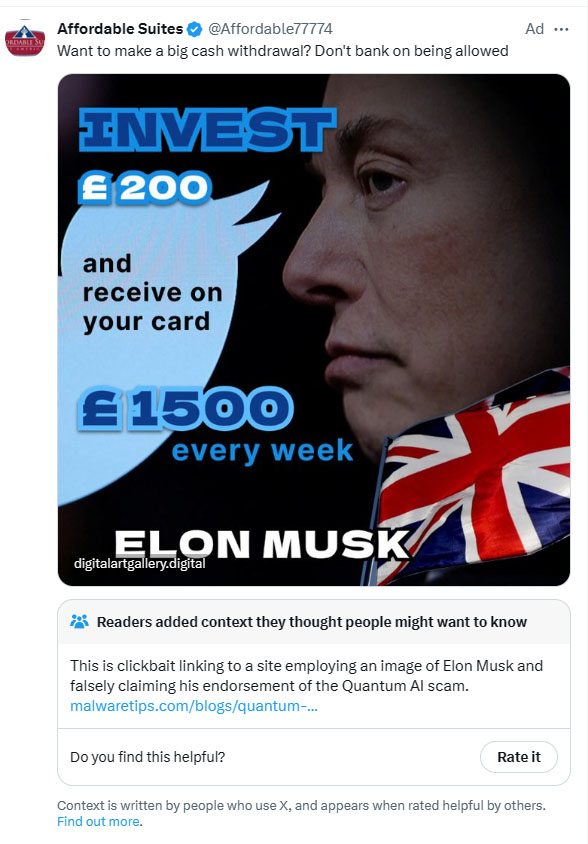
The ads even falsely claim Elon Musk himself endorses it. Yet still, the ads operate on X without getting removed. And another get-rich-quick advert targeting British users exploits the identities of British celebrities to lure Twitter (X) users to spoof news websites promoting investment scams (below).
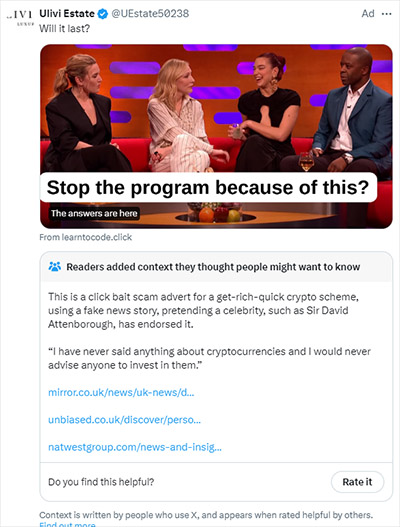
It’s a bizarre approach, but one that feeds into the theory that X is struggling financially, and has opted to rake in the advertising money from scammers amid reports of genuine advertisers fleeing the platform after Musk’s controversial take-over. After all, not only are these scam accounts paying for a blue checkmark, they’re also paying X to get their adverts in the newsfeed of X users.
And while X users are adding community notes in a bid to try and keep other X users safe from scam adverts, the scam ads still appear on the X platform, and consequently they’re always putting users, who may not read the appended community notes, at risk. That’s to say, ‘Community Notes’ is no substitute for removing scams from a platform.
But it seems, at least for the time being, the approach of X is to take the scammer’s money and run, to the detriment of their own users.
Continued below...
Thanks for reading, we hope this article helped, but before you leave us for greener pastures, please help us out.
We're hoping to be totally ad-free by 2025 - after all, no one likes online adverts, and all they do is get in the way and slow everything down. But of course we still have fees and costs to pay, so please, please consider becoming a Facebook supporter! It costs only 0.99p (~$1.30) a month (you can stop at any time) and ensures we can still keep posting Cybersecurity themed content to help keep our communities safe and scam-free. You can subscribe here
Remember, we're active on social media - so follow us on Facebook, Bluesky, Instagram and X
